Growing David Austin’s ‘Gertrude Jekyll’ Rose
When my delivery from David Austin came in last April, there was a mistake in my order and instead of receiving ‘Alnwick Castle’, there was a ‘Gertrude Jekyll’ in the box instead. The company quickly corrected the mistake, and allowed me to keep the Jekyll rose, too, which showed outstanding customer service for one thing, but also made my day because I grew the ‘Gertrude Jekyll’ rose in my old garden and was pleased to have her back. 🙂
‘Gertrude Jekyll’ shows great disease resistance in my garden, but other gardeners complain of black spot. I have yet to see this.
Introduced by David Austin in 1986 this rose is named for the famous author, writer, artist, and influential garden designer Gertrude Jekyll. Arguably one of Austin’s finer creations, it boasts the classic English rose shape and scent with repeat bloom to boot. Growing to heights of about 5′ (taller if trained as a climber), ‘Gertrude Jekyll’ is listed as being hardy in zones 5-10. A good candidate for a large container, this rose’s size can be kept in check with judicial pruning. Ours just completed it’s first flush of blooms and is already sending out new growth for a repeat performance.
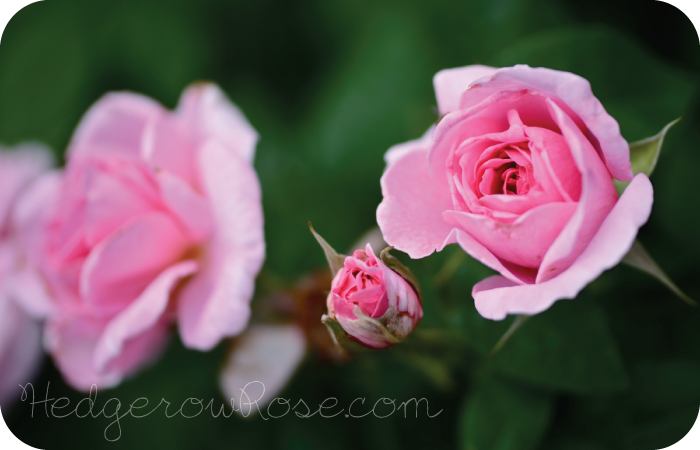
‘Gertrude Jekyll’, like it’s parent ‘Comte de Chambord’, has a very strong, damask rose scent.
‘Gertrude Jekyll’ has very thorny canes and can be tricky to maneuver around when pruning: wear thick gloves! Since it blooms on new wood, prune early and deadhead to increase flowering, but make sure to stop deadheading and feeding your roses several weeks before autumn to prepare them for winter dormancy. Each blossom has an incredibly fragrant, old-rose scent, and measures approximately 4″ across. The bright pink blossoms are fully double, quartered, and are sometimes born singly and sometimes in clusters of 2-3.
‘Gertrude Jekyll’ is a good candidate for a large container and can be trained as a rounded shrub or a climber.
I found that in our garden, ‘Gertrude Jekyll’ has shown very good disease resistance. Some of my other roses are fighting off black spot, but this one hasn’t show a single blemish. However, I’ve read reports that isn’t the case for other gardeners who have had to shovel prune their ‘Gertrude Jekyll’ rose due to fungal disease. (EDIT: Add me to the list of gardeners who had to get rid of this rose for fungal problems! Such a shame to see her go but I was fighting a losing battle with the black spot.)
‘Gertrude Jekyll’ is arguably one of David Austin’s finer creations.
Studying Gertrude Jekyll’s form and scent, her traits are certainly similar to that of her parent rose, the portland damask ‘Comte de Chambord‘ from 1858 which also has a strong fragrance and full, pink blossoms. However, Gertrude Jekyll’s roses tend to have a deeper pink center rather than a uniform pink coloring. Still, if you’re interested in growing Old Garden Roses, ‘Comte de Chambord’ is a beauty.
‘Gertrude Jekyll’ is a winner of the 2002 James Mason Award from the Royal National Rose Society and received a scoring of a “solid to very good rose” from the American Rose Society. You can reserve your plants for next spring by clicking HERE.

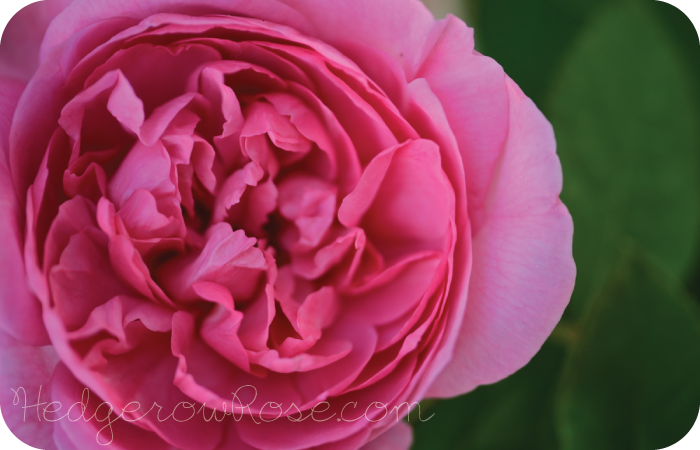
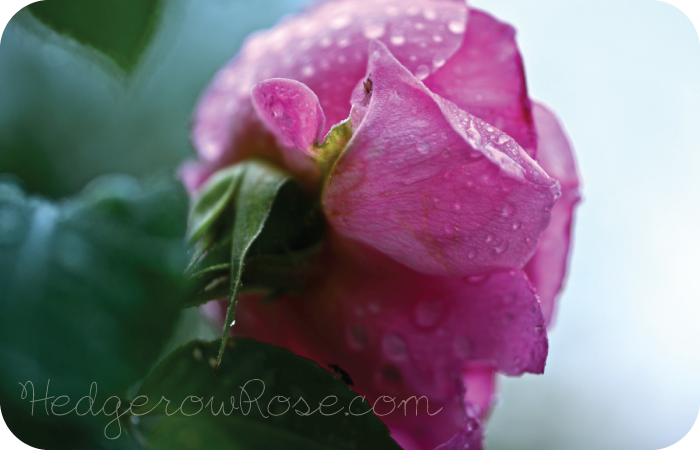
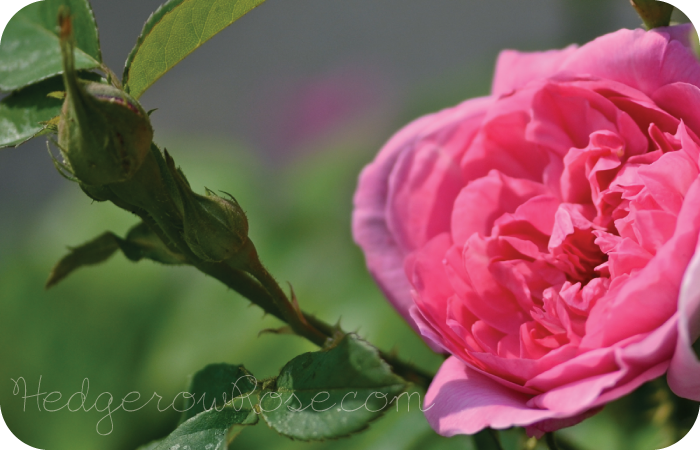
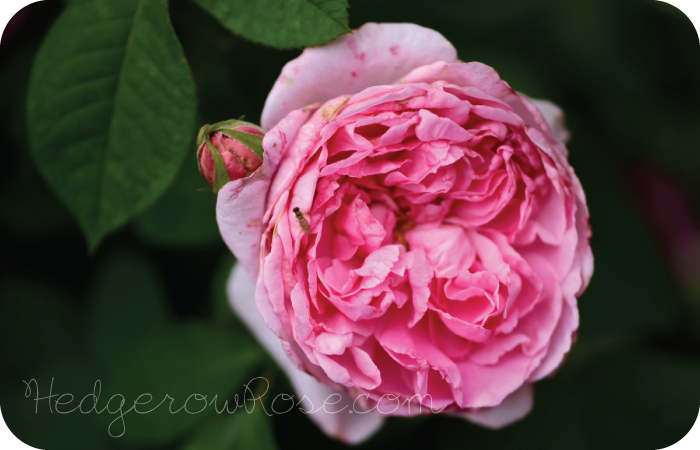
I too have heard reports of the blackspot issue with Austins in general. I know have 8 shrubs of austins and they are doing well as I do employ the methods you mention here. That seems to be the key. Like their Old Garden Rose cousins, they like a while to settle in and put down roots before the big shows begin. For me, this was a 3 year cycle. Sleep.Creep.Leap. Enjoyed this post.
Thanks Chris! Sleep, creep, leap is a favorite saying around here, too, there is a lot of truth to it.
Hi Lara, Many thanks for the lovely welcome to your site. I hope you don’t mind if I immediately have a request? Until a few years ago my neighbor had a very big, black spot-ridden, climbing rose growing on our boundary wall. As a result my garden was always full of the black-spot covered leaves fallen from this rose. Needless to say my roses became very sick and had to be sent off to the `Rose Heaven in the Sky’. However, now that the offending rose has disappeared (died?) I’m getting back into roses again. I presently have just two, Red Flame on a Rose Pergola and Mortimer Sackler growing on a wall. I would like to grow 3 – 4 roses in pots on the patio, I love to sit relaxing with a good book, bathed in the scent of roses and tuberose. I forgot to add that a cocktail to hand greatly enhances the experience! Could you recommend some roses that would feel at home in a pot and, also, what size pot would you recommend? I’ve recently read that cutting back the tap root of roses makes for a much happier pot rose, what do you think?
My apologies for all the questions, I’m sure that you’re inundated with such requests. I’ll send you over a few of my photos soon. Regards, Marilyn
Hi Marilyn! Blackspot is a huge problem in our climate so I feel your pain. I have to have constant vigilance to prevent it from taking over the rose garden. There are some varieties that are very resistant to BS which I am now growing in containers although within another season or two they will probably get too big and must go in the ground. (For example, I have one of my ‘Madame Hardy’ roses in a container and never have any disease issues with her.) Many of the Earth Kind roses are resistant to disease but I know you like fragrance so I would suggest visiting David Austin’s site because a great majority of his roses are suitable for a large container. I particularly like ‘Abraham Darby’ even though it can get BS if the conditions are right, it recovers quickly. Last, I actually wrote a post about growing roses in containers that you might like to check out if you haven’t already: https://hedgerowrose.com/rose-gardening/2012/02/11/some-suggestions-for-growing-roses-in-containers/
Good luck!
when do i prune my gertrude jekyll
Hi Liz, I like to prune my roses when they begin to break dormancy, which for us is sometime around early April (end of winter and into spring.) I don’t like to prune at the end of summer and fall because that stimulates tender new growth which will then be killed by the cold. Hope this helps!
how low down should i prune my gertrude jykell rose this is in its 2nd year of growth and looks a little spindly on the bottom third.
Hi there! Do you have the climbing version of this rose? If not, you can prune down quite a bit. If it’s the climbing version, see instructions for pruning climbers in the link I reference below. For shrubs, I usually take mine down to about 2/3 it’s size (sometimes as low as 1/3 it’s size if I feel it needs a good rejuvenation) and I do this in late winter/early spring. The David Austin website has instructions for that HERE if you’d like to take a look. Heirloom roses also has comprehensive instructions for pruning roses which you can take a look at HERE.
I lay my Gertrude Jekyll ( and several other roses) over and cover with marsh hay. This year I had terrible vole damage. Does anyone have some tips on deterrents? I do raise veggies in the same area and don’t want to poison my family.
Hi Jenella, I’m not sure about the voles but my husband and I have had success with Liquid Fence to keep rabbits and groundhogs away from our veggie garden. Might be worth a try.
I have Gertrude Jekyll rose and it has hardly any scent. What can I do to increase the scent?
Hi Cecile–that’s surprising because this rose is incredibly fragrant. Are you sure you have the correct rose? Could it have been mislabeled?
Hi,
I need your help!
I got à beautiful Gertrude Jekyll for my birthday in mid-May. IT was then in full bloom. I deadheaded it dutifully but for one week when I was on holiday. I had also repotted it just before going on holiday. It has however not produced any new buds and looks pretty sad. Tired looking leaves, some dead and brown leaves. No visible sign of disease though. Any tips on how to make it happy again? (I am new to rose growing).
Thank you in advance.
Ruth
Hi Ruth, It’s difficult to say without seeing photos of your rose but it could be any number of things. In fact, I wonder if it’s getting overwatered? Here is a link to a rose troubleshooting guide that may help you. That being said, I should tell you that my Gertrude Jekyll did not last more than 1 season. Initially, she looked beautiful–flowers galore–but subsequently became ridden with blackspot, lost all her leaves and generally looked terrible. I ended up throwing her out which was a real bummer because I loved the flowers…when she did have them! If I may suggest an alternative David Austin rose which I’ve recently come to love: ‘Princess Alexandra of Kent’. Gorgeous, HUGE, deep pink flowers and much better disease resistance than Jekyll (although the scent isn’t as strong as Jekyll but not many are!) Good luck!
Gertrude Jekyll does not like to repeat in warmer climates! If you prune it back aggressivly after its first flush it will repeat better!In cooler climates it repeats better.One thing you can do is add about two to four cups of earth worm castings around the base of the rose that really helped my Gertrude to repeat much better!The pruning advice came from Michael Marriott at David Austin roses so I know it is good advice.My advice is to add castings three time during growing season at about six weeks apart, myself I add four cups at a time. You cannot burn roots with castings so you don’t have to worry!I also recommend a good organic fertilizer once a month during blooming season ive have tried many and Happy Frog is the one I love the best. It can be purchased online but I get mine through the local flower nursery. Clark27
Thanks for the tip! I love using worm castings on my roses, too. The container-grown ones especially seem to respond to it. 🙂
I have just planted two bare root Gertrude Jekyll roses on either side of stairs and plan to train them as climbers. In front of them I would like to plant Harlow Carr roses and mix them with Hidcote lavender. Can you tell me the distance I hould have between the Gertrudes and Harlows? Also I have seen a photograph of Harlows mixed with lavender. It looks as if they planted one inside of the other (impossible, I know), but that’s the look. Does anyone know how I can achieve this please? I live in Tuscany and bought my Jekylls here. The Harlow Carrs will also come from here so I am assuming the climate is right for them. Thanks very much. Elena Latici
Hi Elena, welcome!
Personally, I like packing my roses in tight while still providing adequate air circulation and the ability to get in there and prune as needed, so my answer would be 2-3′ for spacing the specific roses you mentioned. I compensate for this tight spacing by making sure they have excellent soil with which to grow a deep, healthy root system. As for the lavender, same principle here, I’d plant it close to the base of your roses and let it fill in. These are simply my thoughts, and other gardeners may have a different preference, of course. 🙂 Here’s a link to Paul Zimmerman’s tips for spacing roses which may be of help to you. He talks about the idea of “air circulation” as being irrelevant if you are growing roses that are not disease prone and I totally agree with that, but I know for myself I sometimes grow roses that can get a bit spotty because I love the flowers so much, and giving them a bit of breathing room seems to help. Various roses have varying heights and widths and can get pretty sizable depending on their climate, but again, the roses you mentioned can be packed a bit closer, in my opinion. Last, keep an eye on that Gertrude Jekyll…she turned out to be a bit too disease prone for our garden and was eventually removed (but we were gardening in a very rainy/humid climate.) Sorry for the lengthy answer but I hope it helps!
Hi, I started a new city garden last summer and planted this lovely rose as a climber on a bit south facing wall. To say it has grown vigourously is an understatement, it has covered a huge part of the horrible wall. However I havent had a single flower at all. Is this because its its first year? Should I have pruned it? I go out every few days and theres literally a few more inches on each stem, just no flowers.
Hi Ian! Sounds like you have a healthy plant, well done! In my experience, climbers can take a year or two to really get going and it’s not uncommon for them to give you hardly any blooms during that time. For example, I have a St Swithun (David Austin) climber in our garden that last year gave me ONE flower but this year was literally covered in blooms. Climbers take patience sometimes, so my advice is just keep doing what you’re doing, because it sounds like she’s happy, and see what happens next year. 🙂